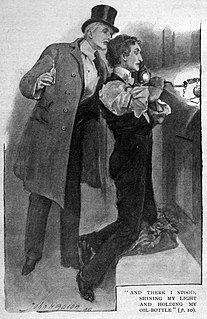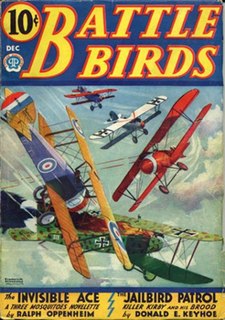Pulp magazines were inexpensive fiction magazines that were published from 1896 to the late 1950s. The term "pulp" derives from the cheap wood pulp paper on which the magazines were printed. In contrast, magazines printed on higher-quality paper were called "glossies" or "slicks". The typical pulp magazine had 128 pages; it was 7 inches (18 cm) wide by 10 inches (25 cm) high, and 0.5 inches (1.3 cm) thick, with ragged, untrimmed edges.

The Maltese Falcon is a 1930 detective novel by American writer Dashiell Hammett, originally serialized in the magazine Black Mask beginning with the September 1929 issue. The story is told entirely in external third-person narrative; there is no description whatsoever of any character's thoughts or feelings, only what they say and do, and how they look. The novel has been adapted several times for the cinema.

Samuel Dashiell Hammett was an American writer of hard-boiled detective novels and short stories. He was also a screenwriter and political activist. Among the enduring characters he created are Sam Spade, Nick and Nora Charles, the Continental Op and the comic strip character Secret Agent X-9.

Zorro is a fictional character created in 1919 by American pulp writer Johnston McCulley, appearing in works set in the Pueblo of Los Angeles in Alta California. He is typically portrayed as a dashing masked vigilante who defends the commoners and indigenous peoples of California against corrupt and tyrannical officials and other villains. His signature all-black costume includes a cape, a hat known as a sombrero cordobés, and a mask covering the upper half of his face.

Black Mask was a pulp magazine first published in April 1920 by the journalist H. L. Mencken and the drama critic George Jean Nathan. The magazine was one of several money-making publishing ventures to support the prestigious literary magazine The Smart Set, which Mencken edited, and which had operated at a loss since at least 1917. Under their editorial hand, the magazine was not exclusively a publisher of crime fiction, offering, according to the magazine, "the best stories available of adventure, the best mystery and detective stories, the best romances, the best love stories, and the best stories of the occult." The magazine's first editor was Florence Osborne.

The Green Hornet is a fictional masked crime-fighting superhero created in 1936 by George W. Trendle and Fran Striker, with input from radio director James Jewell. Since his 1930s radio debut, the character has appeared in numerous serialized dramas in a wide variety of media. The Green Hornet appeared in film serials in the 1940s, The Green Hornet television series in the 1960s, multiple comic book series from the 1940s on, and a feature film in 2011. The franchise is owned by Green Hornet, Inc., which licenses the property across a wide variety of media that includes comics, films, TV shows, radio and books. As of the 2010s, the comic-book rights are licensed to Dynamite Entertainment.
Publication of comic strips and comic books focusing on science fiction became increasingly common during the early 1930s in newspapers published in the United States. They have since spread to many countries around the world.

The Continental Op is a fictional character created by Dashiell Hammett. He is a private investigator employed as an operative of the Continental Detective Agency's San Francisco office. The stories are all told in the first person and his name is never given.
Carroll John Daly was a writer of crime fiction.

The Spider's Web is a 1938 Columbia Pictures movie serial based on the popular pulp magazine character The Spider. The first episode of this 15-chapter serial was double-length and directed by serial and western specialist Ray Taylor and by comedy and serial veteran James W. Horne; it was the fifth of the 57 serials released by Columbia.

Casey, Crime Photographer, known by a variety of titles on radio was a media franchise from the 1930s to the 1960s. The character was the creation of novelist George Harmon Coxe. Casey was featured in the pulp magazine, Black Mask, novels, comic books, radio, film, television and legitimate theatre.
Casey, Crime Photographer was a media franchise, in the 1930s until the 1960s. Created by George Harmon Coxe, the photographer Casey was featured in radio, film, theater, novels, magazines and comic books, and television. Launched in a 1934 issue of the pulp magazine Black Mask, the character Jack "Flashgun" Casey, was a crime photographer for the newspaper The Morning Express. With the help of reporter Ann Williams, he solved crimes and recounted his stories to friends at The Blue Note, their favorite tavern.
George Harmon Coxe was an American writer of crime fiction. He is perhaps best known for his series featuring crime scene photographer Jack "Flashgun" Casey, which became a popular radio show airing through to the 1940s.
George Carroll Sims, better known by his pen names Paul Cain and Peter Ruric, was an American pulp fiction author and screenwriter. He is best known for his novel Fast One, which is considered to be a landmark of the pulp fiction genre and was called the "high point in the ultra hard-boiled manner" by Raymond Chandler.
Raoul Whitfield was an American writer of adventure, aviation, and hardboiled crime fiction. During his writing career, from the mid-1920s to the mid-1930s, Whitfield published over 300 short stories and serials in pulp magazines, as well as nine books, including Green Ice (1930) and Death in a Bowl (1931). For his novels and contributions to the Black Mask, Whitfield is considered one of the original members of the hard-boiled school of American detective fiction and has been referred as "the Black Mask's forgotten man".
Stephen Gould Fisher was an American author best known for his pulp stories, novels and screenplays. He is one of the few pulp authors to go on to enjoy success as both an author in "slick" magazines, such as the Saturday Evening Post, and as an in-demand writer in Hollywood.

Arthur J. Raffles is a fictional character created in 1898 by E. W. Hornung, brother-in-law of Sir Arthur Conan Doyle, the creator of Sherlock Holmes. Raffles is, in many ways, an inversion of Holmes – he is a "gentleman thief", living at the Albany, a prestigious address in London, playing cricket as a gentleman for the Gentlemen of England and supporting himself by carrying out ingenious burglaries. He is called the "Amateur Cracksman" and often, at first, differentiates between him and the "professors" – professional criminals from the lower classes.

Casey, Crime Photographer is an American crime drama television series that aired from April 19, 1951, to June 5, 1952, on the CBS Television Network. The series ran for 57 episodes over two seasons. It was based on the successful radio series of the same name which was based on the novels by George Harmon Coxe.
Singapore Sammy is a fictional pulp character written by George F. Worts, primarily for Argosy, one of his primary markets for fiction. The adventures of Sammy Shay are one of the shorter adventure series characters which Worts wrote.

Battle Birds was an American air-war pulp magazine, published by Popular Publications. It was launched at the end of 1932, but did not sell well, and in 1934 the publisher turned it into an air-war hero pulp titled Dusty Ayres and His Battle Birds, with Robert Sidney Bowen, an established pulp writer, providing a lead novel each month, and also writing the short stories that filled out the issue. Bowen's stories were set in the future, with the United States menaced by an Asian empire called the Black Invaders. The change was not a success, and after a year Bowen wrote a novel in which, unusually for pulp fiction, Dusty Ayres finally defeated the invaders, and the magazine ceased publication. It restarted in 1940, again under the original title, Battle Birds, and lasted for another four years.